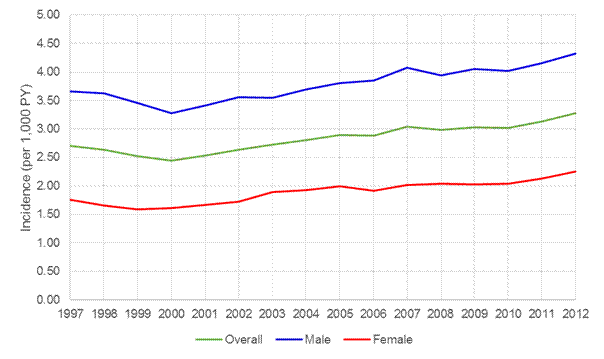Session Information
Session Type: ACR Poster Session A
Session Time: 9:00AM-11:00AM
Background/Purpose:
Gout is increasingly becoming recognized as the
most common form of inflammatory arthritis worldwide; however, no Canadian
general population-based data on the disease burden of gout are available. We
estimated the incidence and prevalence of gout in an entire Canadian province (British
Columbia, BC) from 1997-2012.
Methods:
We utilized Population Data BC, an administrative database spanning the
province of BC (approximately 4.5 million individuals) that includes all
outpatient visits and hospital admissions from 1990-2012. The primary case
definition of gout was at least one recorded diagnosis of gout (ICD-9-CM 274 or
ICD-10-CA M10) at either a physician or hospital visit. We additionally
explored secondary definitions of gout using available detailed medication
dispensation information (obtained from BC PharmaNet), including individuals
with at least two recorded diagnoses of gout or at least one recorded diagnosis
of gout plus at least one dispensation of anti-gout medication (i.e.,
allopurinol, febuxostat, probenecid, or colchicine). To ensure incident gout
cases, we required all newly diagnosed individuals to have at least five years
prior without any record of a gout diagnosis. Annual incidence and prevalence
estimates were age-sex-standardized using 2012 as the reference. Annual
population estimates were obtained from BC Stats.
Results:
Of 4,542,508 individuals in BC in 2012, we identified 173,003 prevalent gout
cases (68% male, mean age 63 years) for an overall prevalence of 3.81%. The
corresponding prevalence in the same calendar year among males and females was
5.22% and 2.41%, respectively. The prevalence additionally increased according
to age group, reaching 11.65% among individuals at least 65 years old. We additionally identified 14,892 incident
cases in 2012 for an overall incidence rate of 3.28 per 1,000 person-years. The
corresponding incidence rates among men and women in 2012 were 4.32 and 2.25,
respectively, per 1,000 person-years. Both the prevalence and incidence of gout
increased substantially over the study period (Figures 1a and 1b). All secondary case definitions of gout showed
similar levels of this increasing trend.
Conclusion:
These findings from BC, representative of the Canadian general population,
indicate that the incidence and prevalence of gout are substantial and have
increased over the past several decades.
Figure
1a. Annual trends of standardized prevalence (%) in
BC, Canada.
Figure
1b. Annual trends of standardized incidence (per
1,000 person-years) in BC, Canada.
To cite this abstract in AMA style:
Rai SK, Avina-Zubieta JA, McCormick N, De Vera M, Shojania K, Sayre EC, Choi HK. Rising Incidence and Prevalence of Gout in the Canadian General Population [abstract]. Arthritis Rheumatol. 2015; 67 (suppl 10). https://acrabstracts.org/abstract/rising-incidence-and-prevalence-of-gout-in-the-canadian-general-population/. Accessed .« Back to 2015 ACR/ARHP Annual Meeting
ACR Meeting Abstracts - https://acrabstracts.org/abstract/rising-incidence-and-prevalence-of-gout-in-the-canadian-general-population/


